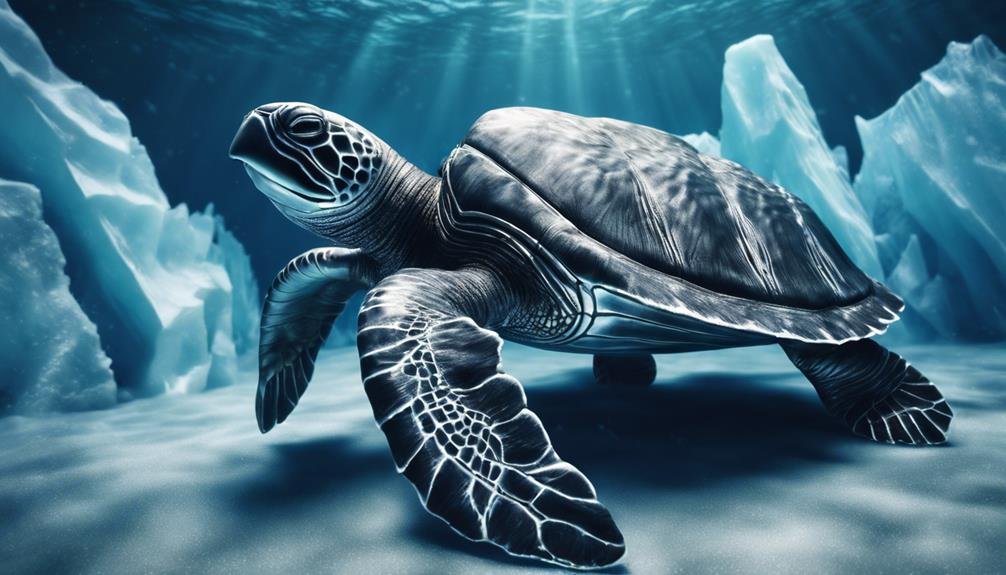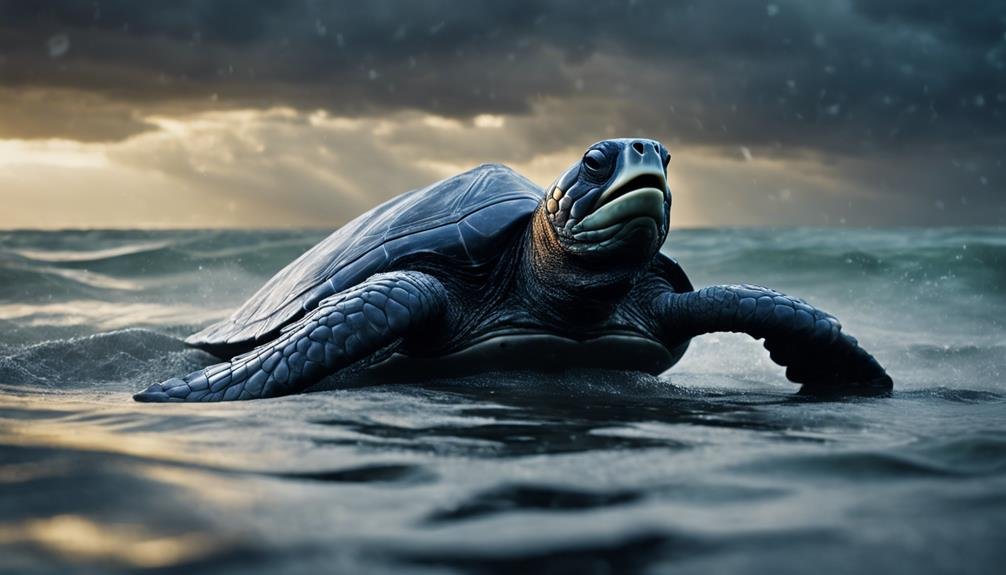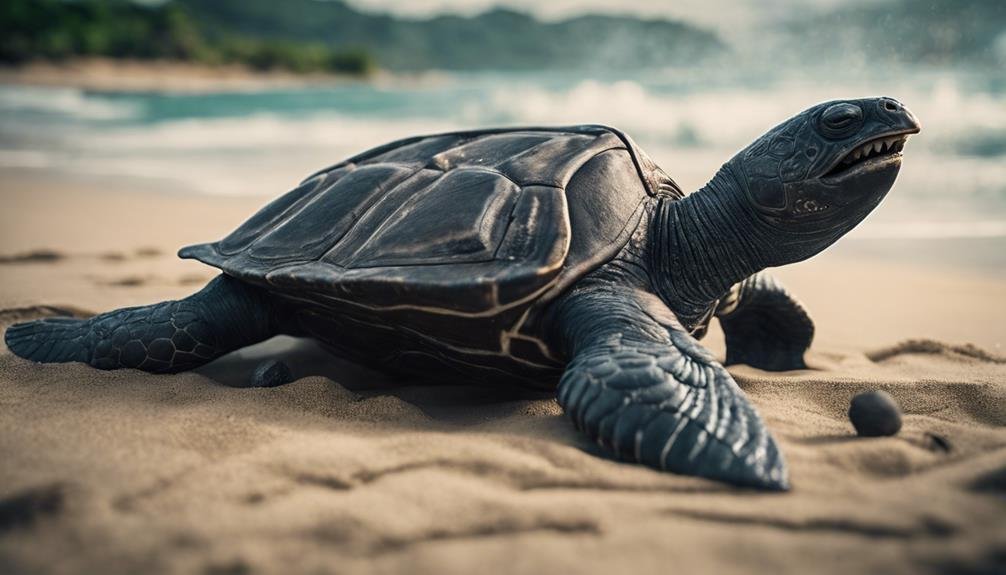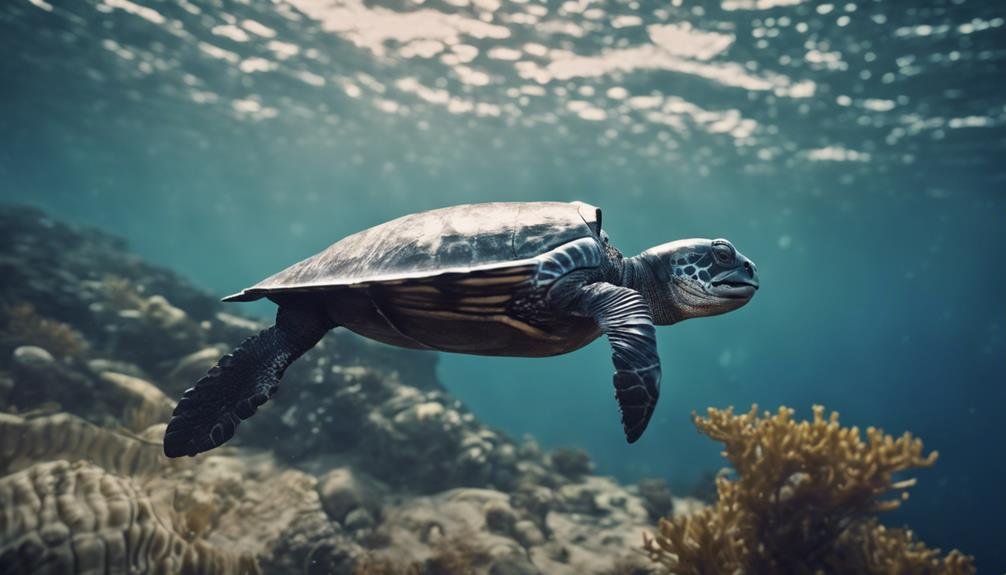You’ve probably heard of leatherback sea turtles, but did you know they’ve been traversing our oceans for around 110 million years? Their journey through time, surviving the late Cretaceous period and witnessing the rise and fall of countless species, paints a vivid picture of resilience and adaptability. As you explore the evolutionary saga of these ancient mariners, consider the secrets they hold about our planet’s past and their critical role in today’s marine ecosystems. Their story isn’t just a tale of survival; it’s a call to action, spotlighting the urgent need for conservation efforts. Let’s uncover what makes these creatures so enduring and why their preservation matters more than ever.
Key Takeaways
- Leatherback sea turtles have existed for approximately 110 million years.
- They originated in the late Cretaceous period, showcasing their ancient lineage.
- Surviving major extinction events, leatherbacks demonstrate remarkable resilience.
- Their evolutionary journey provides insights into prehistoric marine ecosystems.
- Fossil records offer evidence of the leatherback’s long presence on Earth.
Ancient Origins
Leatherback sea turtles, having roamed the planet for around 110 million years, are among the oldest sea turtle species, showcasing a remarkable evolutionary journey. You’re exploring creatures that have witnessed the shifting sands of time, surviving through epochs that saw the rise and fall of countless species. Their ancient origins aren’t just a confirmation of their resilience but also a window into the past, offering you a glimpse into prehistoric marine ecosystems.
As one of the oldest species of sea turtles, leatherbacks have navigated through major extinction events, including those that wiped out the dinosaurs. What’s fascinating is how these ancient mariners have adapted to various environmental changes over millions of years. Their survival strategies, honed over epochs, underline the importance of understanding their life history and conservation needs.
Evolutionary Journey
You’ve learned about the ancient origins of leatherback sea turtles; now, let’s explore their evolutionary journey.
From origins in ancient seas to surviving mass extinctions, these sea turtles have undergone significant morphological changes over time.
Their story isn’t just about survival and their critical roles in marine ecosystems for millions of years.
Morphological Changes Over Time
Over millions of years, the leatherback sea turtle has undergone significant morphological changes to navigate the challenges of ever-changing marine environments. Throughout their evolutionary journey, these ancient creatures have adapted to a myriad of environmental challenges.
Their unique characteristics, such as the absence of scales and a hard shell, didn’t appear overnight. Instead, they’re the result of millions of years of adaptation, shaped by the relentless forces of nature. Fossil records provide a window into this gradual development, showcasing the leatherback’s distinctive features slowly coming into being.
Surviving Mass Extinctions
Amidst the tumultuous epochs that have seen entire species vanish, leatherback sea turtles have stood the test of time, surviving multiple mass extinctions. These ancient species, with over 110 million years under their belts, showcase a remarkable evolutionary history.
Their journey through time isn’t just a tale of endurance; it’s proof of their resilience. Leatherbacks have navigated shifting environmental conditions, adapting to various challenges that would spell doom for less hardy species.
Their ability to thrive in different ecosystems isn’t accidental but the result of millions of years of evolutionary processes. This adaptability has allowed them to remain a constant in the world’s oceans, proving that surviving mass extinctions isn’t just about luck but evolving to meet the challenges head-on.
Turtle Shell Evolution
As you explore the evolution of turtle shells, you’ll find that their development over millions of years is a tale of survival and adaptation. From early shell formation to the diverse shapes and structures seen in species today, these changes highlight the turtles’ ability to adapt to their environments.
Observing modern turtles, you’ll notice how these ancient adaptations continue to serve them in their ecological niches.
Variations Across Species
Exploring the evolution of turtle shells further, it’s clear that variations across species highlight remarkable adaptations, including the flexible, rubbery shell unique to leatherback sea turtles. Unlike any other, this shell enables leatherbacks to thrive in diverse marine environments.
Here’s why their shell adaptations are truly awe-inspiring:
- Flexibility and Strength: The leatherback’s carapace combines resilience with flexibility, allowing it to withstand immense water pressure.
- Hydrodynamic Ridges: These ridges streamline the Leatherback Sea turtle, facilitating dives up to 4,200 feet to great depths.
- Ancient Design: Reflecting their 110-million-year lineage, these shell adaptations have enabled leatherbacks to become the largest, deepest-exploring, and farthest-ranging sea turtles.
Understanding these variations sheds light on the leatherbacks’ survival and the ecological roles different sea turtle species play in marine ecosystems.
Modern Adaptations Observed
Leatherback sea turtles have adapted to develop a unique shell and other features, enabling them to thrive in various marine environments. Their flexible shell and the ridges on their carapace have improved their hydrodynamics, making them exceptional swimmers. These modern adaptations highlight their resilience, including their ability to dive deep and stay submerged for long periods. Leatherbacks can maintain warm body temperatures in cold waters, demonstrating their adaptability.
| Feature | Impact on Leatherback |
|---|---|
| Flexible shell | Enhances swimming efficiency |
| Ridges on carapace | Improves hydrodynamics |
| Deep diving ability | Allows access to deeper prey |
| Warm body temperature maintenance | Enables survival in cold waters |
Adaptations to Cold


Despite frigid waters, leatherback sea turtles can keep themselves warm through remarkable biological adaptations. These ancient mariners have evolved with unique features enabling them to thrive in cold water, demonstrating extraordinary resilience and contributing to their global distribution. Their large body size, strategic changes in swimming activity, precise adjustments in blood flow, and thick layers of fat are key adaptations that allow them to maintain a warm body temperature, even in icy waters.
Leatherback sea turtles are not just survivors but adept navigators of the world’s oceans. They can dive to depths of 4,200 feet and stay submerged for up to 85 minutes. This ability to plunge into the deep, cold abyss and emerge unscathed reflects their incredible adaptations.
| Adaptation | Benefit |
|---|---|
| Large Body Size | Reduces heat loss |
| Swimming Activity Changes | Generates body heat |
| Blood Flow Adjustments | Optimizes heat distribution |
| Thick Layer of Fat | Insulates against cold |
| Resilience to Environmental Changes | Supports global distribution |
Reproductive Behaviors
You’ll find their reproductive behaviours fascinating as you explore the world of leatherback sea turtles.
They carefully select their nesting sites on the beaches where they were born and engage in unique mating rituals.
These practices, essential for their survival, are intriguing yet threatened by human impacts.
Nesting Sites Selection
When selecting nesting sites, leatherback sea turtles prioritize factors like sand temperature and moisture levels to secure the survival of their future offspring. Their remarkable journey back to their birthplace demonstrates an incredible natal homing behaviour and a deep connection to their origins. They rely heavily on environmental cues to find that perfect spot where the sand temperature is just right for their eggs.
Here are three reasons why their choice of nesting sites strikes an emotional chord:
- It showcases their instinctual dedication to the next generation.
- The meticulous selection process underscores the fragile balance of nature.
- It highlights the turtles’ resilience and adaptability in changing environmental conditions.
Female leatherbacks’ ability to detect the perfect conditions for their nests ensures that their ancient lineage continues against all odds.
Mating Rituals Observed
After exploring how leatherback sea turtles select their nesting sites, let’s focus on their mating rituals, which are equally intriguing and essential for survival. Leatherback sea turtles engage in complex courtship behaviours, including nuzzling, biting, and circling each other, showcasing a fascinating aspect of their lives.
Male competition is fierce; males demonstrate dominance through physical interactions to win over females. These rituals aren’t just about strength and ensuring genetic diversity among their offspring.
Major Threats


Leatherback sea turtles face major threats that greatly impact their survival, including entanglement in fishing gear and ingesting marine debris. These ancient mariners, who’ve navigated the world’s oceans for millions of years, are now struggling against challenges they can’t simply swim away from. There are many dangers, but let’s focus on the most grievous ones.
- Entanglement in Fishing Gear: This issue is far more than a mere inconvenience; it’s often a death sentence. As these turtles travel vast distances, they encounter numerous fishing operations. The resulting entanglement causes immediate physical harm and contributes significantly to this ancient species’ population decline.
- Ingestion of Marine Debris: Plastic pollution in our oceans is a global crisis and a lethal meal for leatherbacks. Mistaking plastic for jellyfish, their primary food leads to ingestion, which can cause internal injuries or starvation.
- Egg Harvest: In many parts of the world, the eggs of leatherback sea turtles are considered a delicacy. This practice diminishes their numbers and threatens the species’ future reproductive success.
These threats highlight the urgent need for conservation efforts to protect and recover the vulnerable leatherback sea turtle population.
Conservation Milestones
Acknowledging leatherback sea turtles’ severe threats, it’s heartening to see significant conservation milestones achieved to protect this ancient species. Efforts to safeguard these creatures have focused on protecting nesting beaches, a critical step in ensuring the survival of future generations. By establishing protected areas and implementing beach management practices, conservationists combat habitat loss and provide safe havens for leatherback turtles to lay their eggs.
Reducing bycatch in fishing gear has been a pivotal conservation milestone in addition to securing nesting sites. Collaborative efforts between conservation organizations and the fishing industry have led to developing and adopting turtle-friendly fishing practices. These initiatives help reduce the accidental capture of leatherback turtles and support sustainable fishing practices.
Research Highlights


Delving into the research on these ancient mariners reveals how they’ve navigated survival challenges across millennia. Leatherback sea turtles have witnessed the dinosaurs’ rise and fall and thrived through ice ages and periods of significant climatic upheaval. Their tale is one of resilience, an awe-inspiring journey through time that underscores the importance of conserving such an enduring species for the health of marine ecosystems.
Research highlights include:
- Fossil Records: Evidence dating back 110 million years showcases the leatherback’s ancient lineage, providing a window into their evolutionary history.
- Survival Through Environmental Changes: These turtles have survived major climate and sea-level shifts, highlighting their adaptability and critical role in maintaining the balance within marine ecosystems.
Future Prospects
Despite their ancient lineage, leatherback sea turtles now face a critical juncture in their survival, with their future heavily dependent on our actions today. The prospects of these magnificent creatures aren’t set in stone; they’re shaped by the conservation efforts we commit to and the awareness we spread. Their population has declined by 40% over the past three generations, signalling a red alert for environmentalists and governments alike.
The call to action is clear. Embrace sustainable practices, support policies that protect marine habitats, and join forces with international conservation groups. How Have Leatherback Sea Turtles Managed to Survive for So Long on Earth?
The remarkable resilience of leatherback sea turtles can be attributed to their ability to adapt to various leatherback sea turtle habitats. These ancient creatures have evolved to thrive in multiple environments, from tropical beaches to open oceans, allowing them to survive millions of years on Earth.
Conclusion
You’ve journeyed through the ancient world of leatherback sea turtles, marvelling at their 110 million-year-old legacy. These incredible creatures have weathered evolutionary storms, adapted to chilling depths, and faced challenging threats to their survival.
Their story isn’t just about endurance; it’s a call to action. By understanding and protecting leatherbacks, you’re safeguarding a piece of our planet’s history and ensuring future generations can witness these living dinosaurs.
Let’s honour their legacy by committing to their conservation.
FAQs
1. How Long Have Leatherback Sea Turtles Roamed Our Planet?
You’re diving into a fascinating question: how long have leatherback sea turtles been around?
These incredible creatures have roamed our planet for about 110 million years. They’ve witnessed dinosaurs and survived mass extinctions, barely changing through the aeons.
Their presence marks them among the oldest living sea turtles, and they play a significant role in marine ecosystems.
Their journey is a tribute to resilience and the power of adaptation.
2. When Did the Leatherback Sea Turtle First Appear?
You’re diving into the history of one of the most ancient creatures on Earth when you ask about the first appearance of leatherback sea turtles.
Their story is proof of survival through the aeons.
3. How Long Have Sea Turtles Been on Our Planet?
You’re probably wondering how long sea turtles have been around, right? Well, they’ve been cruising our oceans for 110 million years!
These ancient mariners have seen it all, from dinosaurs to smartphones. They’ve adapted to countless changes and are essential in keeping our marine ecosystems balanced.
4. How Long Have Turtle Species Been Around?
You might be wondering how long turtle species have been gracing our planet. These ancient creatures have been around for a staggering 110 million years!
They’ve seen dinosaurs come and go, survive major extinction events, and continue to evolve. Leatherback sea turtles, part of this resilient group, showcase the incredible journey of survival and adaptation.
Their history is fascinating and a tribute to the enduring presence of marine reptiles on Earth.
Related Article
https://thereptileguide.com/how-big-do-corn-snakes-get/
https://thereptileguide.com/do-bearded-dragons-like-water-swimming-bathing/


